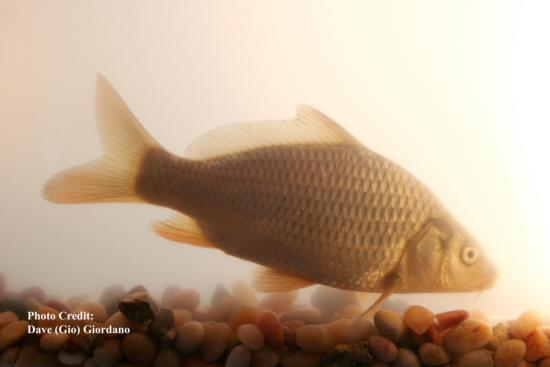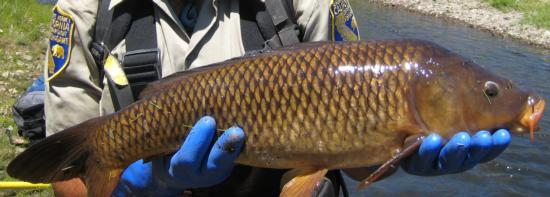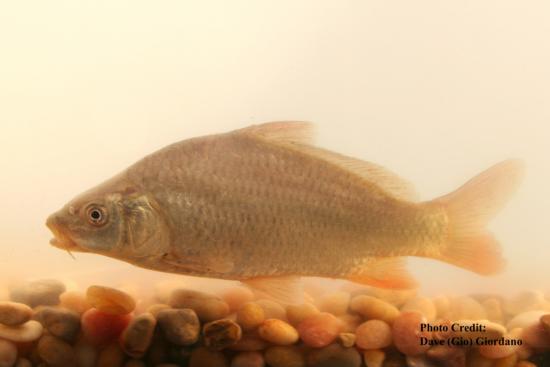Common Carp
-
Scientific NameCyprinus carpio
-
NativeNon-Native
-
Identification
 Common carp approximately 18 cm (7”) long. Location: Suisun Marsh, California. Date: 8/8/2008
Common carp approximately 18 cm (7”) long. Location: Suisun Marsh, California. Date: 8/8/2008 Common carp. Captured in the upper Feather River near Portola, CA in July 2008. Photo by Dan Worth, California Department of Fish and Game.
Common carp. Captured in the upper Feather River near Portola, CA in July 2008. Photo by Dan Worth, California Department of Fish and Game. Common carp approximately 18 cm (7”) long. Location: Suisun Marsh California Date: 8/6/2007
Common carp approximately 18 cm (7”) long. Location: Suisun Marsh California Date: 8/6/2007- Heavy bodied
- Large scales
- Sub terminal mouth with two pairs of barbels on the upper lip
- Juveniles have terminal mouths and smaller barbels
- Rear barbels are longer than the front pair
- Dorsal and anal fins have 1 large and 2 smaller serrated spines
- Adults: gold-green to bronze in color with pectoral, pelvic, and anal fins tinged in red
- Juveniles: brown to gray in color
- Fin rays: dorsal 17-21 (after spines), anal 5-6 (after spines),pelvic 5-7, caudal 19
- Lateral line scales: 32-38 (may be much less in some varieties)
-
Life History
Common carp are most often found in the warm, turbid waters of eutrophic lakes, reservoirs, and sloughs with silty bottoms and high vegetation growth or in turbid, alkaline streams with deep permanent pools, and soft bottoms. These are only optimal preferences however, as common carp can be found in a wide range of habitats with specimens being found in waters as cold as 4°C and as warm as 31-36°C, salinities up to 16 ppt, and dramatically low levels of dissolved oxygen (between 0.5 and 3.0 ppm). These tolerances have allowed common carp to quickly settle into lakes and streams with harsh conditions and they are often the first species to return to an area after a drought. Common carp stay in shallow areas where they forage for most of the year but will overwinter in the deeper areas of their range. They leave these secure depths in spring to root through the soil for aquatic insect larvae, small mollusks, crustaceans, and annelid worms. Newly hatched larvae feed purely on algae and zooplankton but can eat most available invertebrates by the time they are a year old. Adults will also feed on plants and algae but this appears to be less important to their diet.
As water temperatures begin to exceed 15°C in spring and early summer, large shoals of common carp will begin mating, reaching peak activity when the water is between 19°C and 23°C. This usually occurs in the late evening and early morning but can happen at any time of the day. Spawning behavior starts with a large school swimming around slowly before breaking off into smaller groups, usually one female and 2 or 3 males that swim to shallow, weedy areas to spawn. Females lay 500 eggs at a time and can lay between 50,000 and 2,000,000 in a single season. Eggs adhere to the sides of aquatic plants and hatch 3-6 days later. The 3-7 mm offspring then fall to the river bottom and feed off their yolk sack before finding cover in aquatic vegetation about a week later. They will not leave the safety of this cover until they are 7-10 cm in length. Growth is determined by a variety of factors including summer temperatures, water quality, and food abundance so by the first summer young common carp can be anywhere between 7 cm and 36 cm long but average between 10 cm and 15 cm. They will usually double in size by the second summer, and then increase by 10-12 cm annually until growth slows in the fourth or fifth year. Common carp usually live between 12 and 15 years in the wild and average a length of 80 cm and a weight of 4.5 kg. Captive individuals have been found to live up to 47 years and weights have been recorded up to 37.9 kg.
-
Links to Other ResearchN / A
-
WatershedN / A
Please note, watersheds are at the USGS 8-digit Hydrologic Unit Code (HUC) scale, so they often include a lot of sub-watersheds. If a species occurs in any sub-watershed within the HUC, the species appears within the HUC. Link to an EPA page that shows HUCs.


